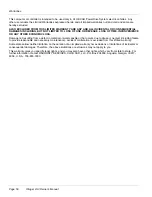
Batteries
Deionized water is the purest form of water, but it is also the most expensive. Deionization removes all ionizable
particles (organic and inorganic) from water through ion exchange. Positively and negatively charged ions are removed
from the water and replaced with H+ and OH- ions. When these two ions are combined, they form H2O, or purified
water.
Reverse osmosis is a method of removing solids from water by forcing it through a membrane. The membrane
rejects all solids while allowing purified water to pass through. The choice of membrane determines the amount
of impurities that the water may contain.
Water from municipal supplies, ponds and wells usually contain detrimental levels of dissolved minerals and chemicals.
If using tap water, it is important to use an in-line deionizer to remove impurities that can damage batteries and
significantly reduce battery life. If tap water is used without a deionizer, regular water analyses must be conducted to
check for impurities because water companies commonly revise their additives on a periodic basis. The following
chart lists the maximum allowable minerals, solids, and contaminates in parts per million and their impact on battery
performance. Your local water company should be able to perform testing and compare their results to the chart.
If using tap water, Club Car’s Service Parts Department offers two different deionzier systems: one for vehicles
equipped with the Single Point Water System (SPWS) CC P/N AM1240701 and the other for vehicles without SPWS,
CC P/N AM10974.
IMPURITY
ALLOWABLE CONTENT (PARTS
PER MILLION)
EFFECTS OF IMPURITY
Suspended matter
Trace
-
Total solids
100.0
-
Organic and volatile matter
50.0
Corrosion of positive plates
Ammonia
8.0
Slight self-discharge of both plates
Antimony
5.0
Self-discharge, reduces life, lower
on-charge voltage
Arsenic
0.5
Self-discharge, can form poisonous gas
Calcium
40.0
Increase of positive plate shedding
Chloride
5.0
Loss of capacity in plates, greater loss
in positive plates
Copper
5.0
Increased self-discharge, lower
on-charge voltage
Iron
3.0
Increased self-discharge, lower
on-charge voltage
Magnesium
40.0
Reduced life
Nickel
None allowed
Intense lowering of on-charge voltage
Nitrates
10.0
Increased sulfation of negative plate
Nitrates
5.0
Plate corrosion, loss of capacity, reduced life
Platinum
None allowed
Violent self-discharge, lower on-charge voltage
Selenium
2.0
Positive plate shedding
Zinc
4.0
Slight self-discharge of negative plates
BATTERY CARE – VEHICLES WITHOUT THE SINGLE-POINT WATERING SYSTEM
To keep batteries in good working condition, follow this maintenance program on a regular basis. Proper battery
maintenance is critical not only for good performance, but also for safe operation.
See following WARNING.
Villager LSV Owner’s Manual
Page 35
















































